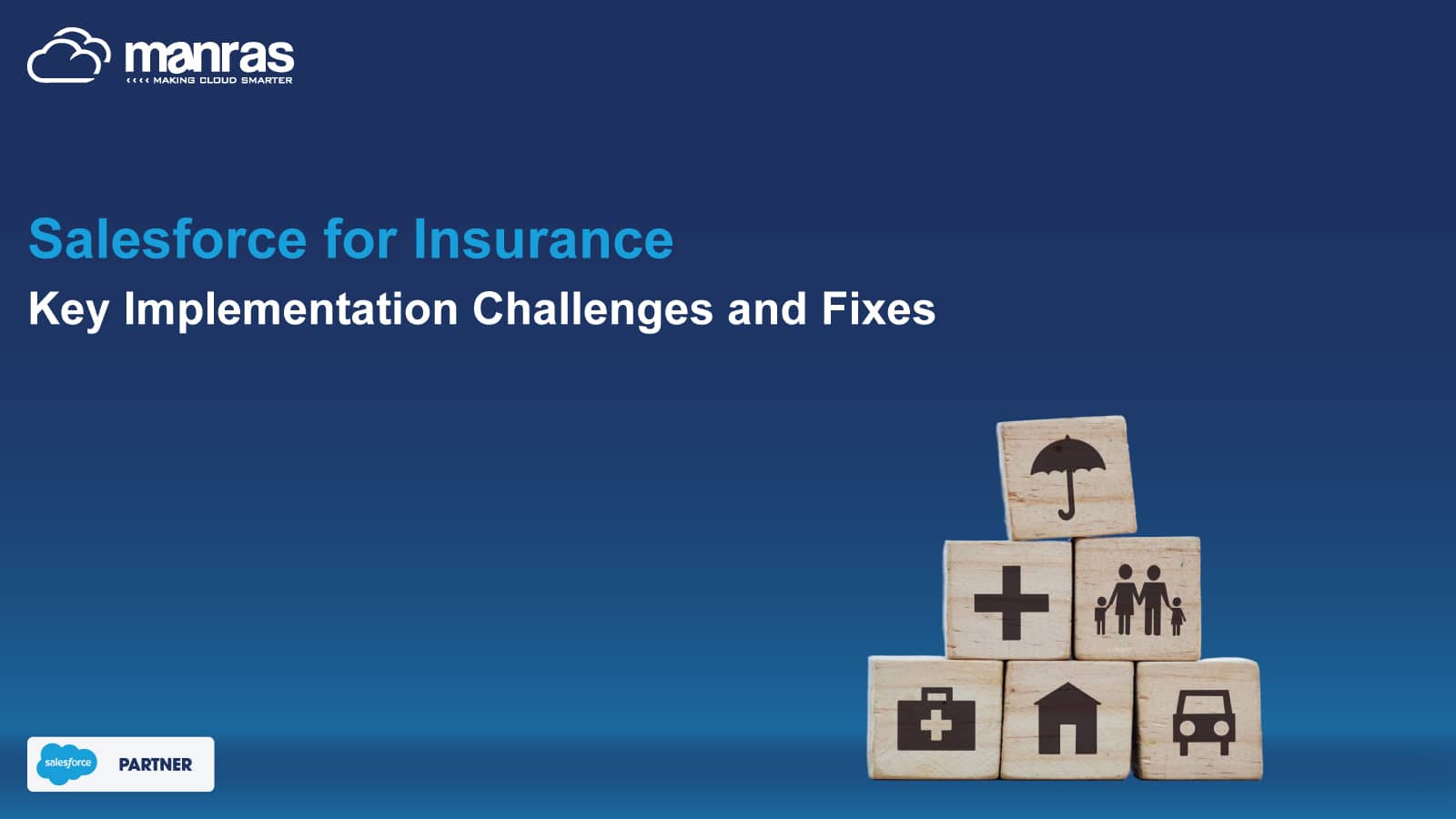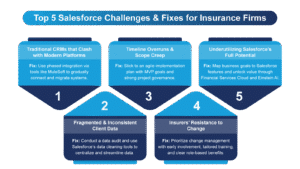
Salesforce for Insurance: Key Implementation Challenges and Fixes
With evolving customer demands, digital disruption, and increasing regulatory pressure, insurance firms must ban traditional systems and adopt modern CRM solutions. Moreover, if they want to stay relevant in the market, insurers should invest in advanced customer service and operational systems. This is where adopting Salesforce for Insurance is wise choice.
Hosted on cloud, Salesforce is an AI-driven, versatile solution that enables insurance agencies to manage policies, claims, and underwriting more efficiently. Also, it helps insurers manage customer engagement and other insurance-related operations, hassle-free. But, Salesforce integration is not as seamless as it looks.
Traditional CRM integration, maintaining data consistency, and meeting strict regulatory guidelines are some of the hurdles you may face when implementing Salesforce for Insurance.
This post covers the primary challenges in implementing Salesforce for insurance agents. As well, we will cover how to resolve these pitfalls.
Why Insurance Firms Need a CRM Platform?
Insurance is much more than just ‘policies.’ It’s about strengthening client relationships, being more responsive, and delivering excellent support services. Today’s customer has limited time and expects instant updates and personalized experiences — something outdated CRMs often struggle to deliver.
Salesforce for insurance agency helps insurance professionals automate workflows and centralize client data. The platform offers seamless collaboration across service, sales, claims, and policy management. Unlike traditional CRM tools, Salesforce provides a 360-degree view of customers, from first contact to renewal, that allows insurers to act rapidly and record interactions across channels.
Furthermore, Salesforce for insurance ensures data consistency, which is vital for underwriting, compliance, and risk mitigation. More critically, Salesforce is highly agile and scalable, allowing agencies to adapt to emerging market trends, release new products faster, and maintain compliance in real time.
5 Key Challenges in Implementing Salesforce for Insurance
While Salesforce brings the most robust and feature-rich functionalities to insurance professionals, its implementation comes with numerous obstacles. Therefore, understanding these issues beforehand and having a clear picture to resolve them is key to success.
Let’s take a look at things that often go wrong and how to fix them.

Traditional CRMs that Clash with Modern Platforms
Various insurance companies still rely on traditional CRM systems built ages ago. Neither of these systems was designed to share data in real time nor integrate with cloud-powered platforms like Salesforce. They use outdated databases, lack third-party integrations, and are only good for routine operations. Eradicating them without disrupting business operations seems impossible.
Solution: Rather than undergoing complete replacement, insurance firms can opt for phased integration using platforms like MuleSoft. Start by connecting historical data or less important workflows before switching to real-time operations. Keep working with hybrid systems until full migration is feasible.
Fragmented & Inconsistent Client Data
Oftentimes, client data in insurance firms is siloed across servicing, claims, underwriting, and insurer portals. Thus, it’s not uncommon to see inconsistency and redundancy in records — different contact details, mismatched policy statuses, or incomplete claim history. This disorganized approach results in poor customer experiences and impacts compliance and reporting.
Solution: Salesforce for insurance offers powerful data management abilities that, when combined with a well-defined data strategy, are very helpful. Start with a complete data audit, implement redundancy logic by leveraging Salesforce’s data cleaning features. Also, this ensures all departments are on the same page and follow consolidated data entry rules.
Timeline Overruns & Scope Creep
Your Salesforce projects suffer significantly without the presence of a disciplined implementation method. It includes budget overruns, delivery delays, or misalignment with business goals. Insurers often try to put on too much customization too soon or shift priorities mid-way, resulting in confusion and burnout.
Solution: Utilize an agile approach with short, value-oriented sprints. Define a clear MVP (Minimum Viable Product), align timelines with stakeholder availability, and put a change control process in place. Tools like Jira or Asana can help keep tasks transparent and on schedule.
Insurers’ Resistance to Change
Many insurance agencies have an agent team and established workflows accustomed to traditional CRMs. Shifting to a system may bring uncertainty, especially when your insurance agents fear increased workloads, job redundancy, or complex learning curves. Hence, this reluctance greatly delays adoption and decreases ROI.
Solution: Develop a well-structured and sought-after change management strategy. Start with involving stakeholders early, spotting champions within company units, and providing expert training sessions. This training should not be just about functionalities, but how Salesforce will transform specific job roles. Talk to your team about the benefits of this adoption, showing how Salesforce for insurance allows rapid service, fewer admin tasks, and better KPI tracking.
Underutilizing Salesforce’s Full Potential
A myriad of insurance professionals opt for Salesforce CRM for contact or lead management. They overlook powerful features, such as automation, Einstein Analytics, and customized apps through Salesforce Financial Services Cloud. This ignorance and shallow implementation result in lost opportunities, causing a significant dip in revenue.
Solution: First, understand and define outcomes beforehand, such as reducing quote turnaround time or boosting claims resolution. Now, align Salesforce features directly to these goals, and then, leverage specialized features to unlock insurance-specific workflows. Reach out to experienced partners to optimize platform value.
Final Words
Salesforce is the world’s #1 and one of the most powerful CRM systems available in the insurance space. With Salesforce for insurance, your firm can modernize client service, simplify workflows, and utilize its data more smartly. From customer engagement to policy renewal and claim automation, the CRM provides foolproof solutions that meet the needs of agents, brokers, and carriers. However, understanding its full potential requires more than technology. You need the right strategy, tools, and implementation know-how.
That’s where Manras Technologies steps in. As certified Salesforce consultants, we help insurance companies plan, build, and optimize Salesforce solutions that resonate with their business objectives. Doesn’t matter if you are starting from the ground up, migrating from traditional CRM systems, or implementing Salesforce Insurance Cloud in your business, our experts can help. Reach out to us today.
For more insights, updates, and expert tips, follow us on LinkedIn.



